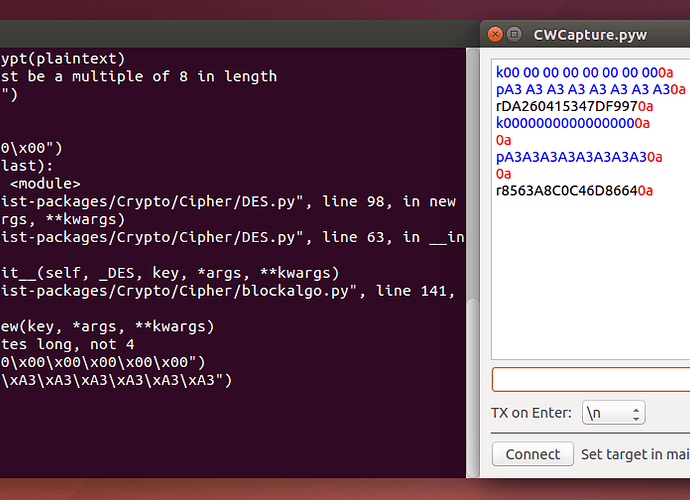About using ChipWhisperer Lite with DES, I made a new firmware image for the XMEGA target on the ChipWhisperer Lite. I used the SimpleSerial-Base as my starting point, and compiled it with the DES code from avrcryptolib. Below is the code. I captured some traces, and the CWAnalyzer.pyw insists on trying to recover an AES key, not DES or something else. Furthermore, it complains about encountering NaN’s when showing the probability of any byte in the key sequence. So how would I go about using DES with CWLite, and is my code below correct? The code does compile, and I was able to push the resulting .hex file to the board. When I capture traces against it, the power usage graph is much different from the AES graph. I just want to make sure issues with the different key size are handled properly, and that the CWAnalyzer.pyw is able to still work.
/*
This file is part of the ChipWhisperer Example Targets
Copyright (C) 2012-2015 NewAE Technology Inc.
This program is free software: you can redistribute it and/or modify
it under the terms of the GNU General Public License as published by
the Free Software Foundation, either version 3 of the License, or
(at your option) any later version.
This program is distributed in the hope that it will be useful,
but WITHOUT ANY WARRANTY; without even the implied warranty of
MERCHANTABILITY or FITNESS FOR A PARTICULAR PURPOSE. See the
GNU General Public License for more details.
You should have received a copy of the GNU General Public License
along with this program. If not, see <http://www.gnu.org/licenses/>.
*/
#include "hal.h"
#include <stdint.h>
#include <stdlib.h>
#include "des.h"
#define IDLE 0
#define KEY 1
#define PLAIN 2
char hex_lookup[16] = {'0', '1', '2', '3', '4', '5', '6', '7', '8', '9', 'A', 'B', 'C', 'D', 'E', 'F'};
uint8_t* hex_decode(const char *in, int len,uint8_t *out)
{
unsigned int i, t, hn, ln;
for (t = 0,i = 0; i < len; i+=2,++t) {
hn = in[i] > '9' ? (in[i]|32) - 'a' + 10 : in[i] - '0';
ln = in[i+1] > '9' ? (in[i+1]|32) - 'a' + 10 : in[i+1] - '0';
out[t] = (hn << 4 ) | ln;
}
return out;
}
void hex_print(const uint8_t * in, int len, char *out)
{
unsigned int i,j;
j=0;
for (i=0; i < len; i++) {
out[j++] = hex_lookup[in[i] >> 4];
out[j++] = hex_lookup[in[i] & 0x0F];
}
out[j] = 0;
}
#define BUFLEN 64
uint8_t memory[BUFLEN];
uint8_t tmp[BUFLEN];
uint8_t ctxt[16];
char asciibuf[BUFLEN];
uint8_t pt[16];
int main
(
void
)
{
platform_init();
init_uart();
trigger_setup();
/* Uncomment this to get a HELLO message for debug */
/*
putch('h');
putch('e');
putch('l');
putch('l');
putch('o');
putch('\n');
*/
/* Super-Crappy Protocol works like this:
Send kKEY
Send pPLAINTEXT
*** Encryption Occurs ***
receive rRESPONSE
e.g.:
kE8E9EAEBEDEEEFF0F2F3F4F5F7F8F9FA\n
p014BAF2278A69D331D5180103643E99A\n
r6743C3D1519AB4F2CD9A78AB09A511BD\n
*/
char c;
int ptr = 0;
char state = 0;
while(1){
c = getch();
if (c == 'x') {
ptr = 0;
state = IDLE;
continue;
}
if (c == 'k') {
ptr = 0;
state = KEY;
continue;
}
else if (c == 'p') {
ptr = 0;
state = PLAIN;
continue;
}
else if (state == KEY) {
if ((c == '\n') || (c == '\r')) {
asciibuf[ptr] = 0;
hex_decode(asciibuf, ptr, tmp);
/* KEY LOAD WOULD GO HERE */
state = IDLE;
} else {
asciibuf[ptr++] = c;
}
}
else if (state == PLAIN) {
if ((c == '\n') || (c == '\r')) {
asciibuf[ptr] = 0;
hex_decode(asciibuf, ptr, pt);
/**********************************
* Start user-specific code here. */
trigger_high();
des_enc(ctxt, pt, tmp);
//16 hex bytes held in 'pt' were sent
//from the computer. Store your response
//back into 'pt', which will send 16 bytes
//back to computer. Can ignore of course if
//not needed
trigger_low();
/* End user-specific code here. *
********************************/
/* Print Results */
hex_print(ctxt, 16, asciibuf);
putch('r');
for(int i = 0; i < 32; i++){
putch(asciibuf[i]);
}
putch('\n');
state = IDLE;
} else {
if (ptr >= BUFLEN){
state = IDLE;
} else {
asciibuf[ptr++] = c;
}
}
}
}
return 1;
}
 That’s the idea of it being open-source!
That’s the idea of it being open-source!
